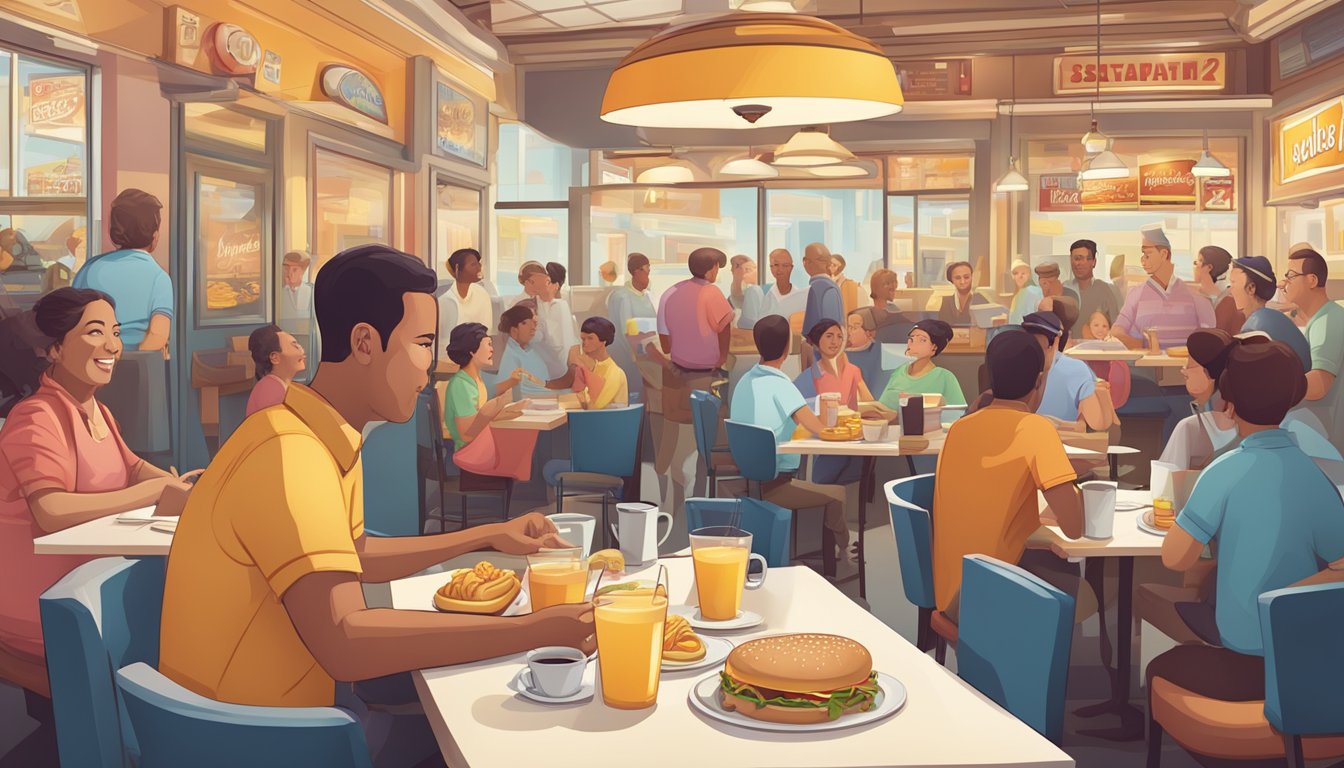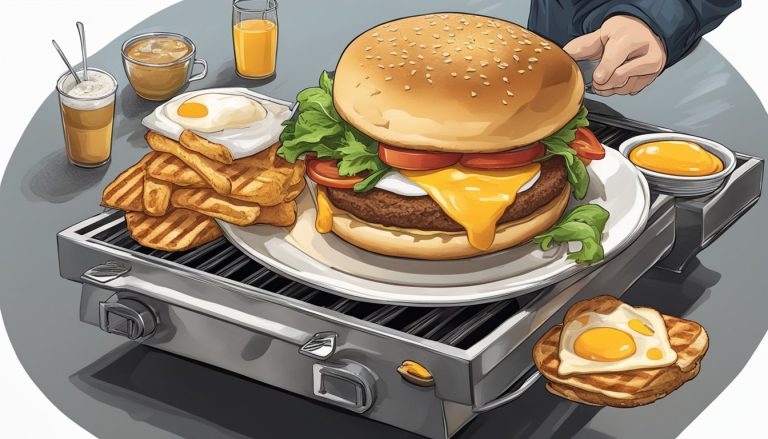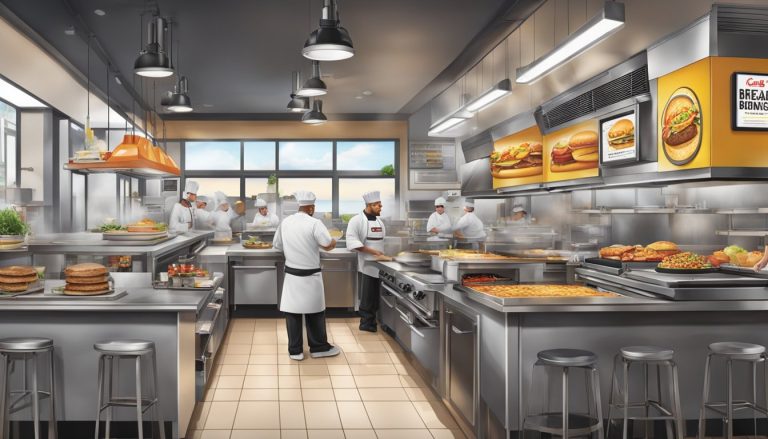Carl’s Jr. and Hardee’s, two iconic fast-food chains, have long been the subject of debate among breakfast enthusiasts. While these restaurants share a parent company, they maintain distinct identities and menu offerings.
The key difference lies in their regional presence – Carl’s Jr. dominates the western United States, while Hardee’s is a staple in the South and Midwest. This geographical split has led to some variation in their breakfast menus, catering to local tastes and preferences.
Both chains are renowned for their hearty breakfast options, featuring items like biscuits, breakfast sandwiches, and hash rounds. The Great Debate between Carl’s Jr. and Hardee’s breakfast often centers on which chain offers superior quality, variety, and value. Food critics and customers alike continue to weigh in on this culinary rivalry, making it a topic of ongoing discussion in the fast-food world.
Historical Overview

Carl’s Jr. and Hardee’s trace their roots to ambitious entrepreneurs who built fast food empires. Their paths intersected through corporate acquisitions, leading to a complex relationship between the two brands.
Founding Stories
Carl Karcher launched Carl’s Jr. in 1941, starting with a hot dog cart in Los Angeles. His business acumen drove rapid growth, expanding from a single cart to multiple drive-in restaurants.
Wilber Hardee founded Hardee’s in 1960 in Greenville, North Carolina. The first Hardee’s restaurant gained popularity for its charbroiled burgers, setting the stage for swift expansion across the Southeastern United States.
Both founders shared a vision for quality fast food and efficient service, laying the groundwork for their future success.
Growth and Expansion
Carl’s Jr. grew steadily throughout the Western United States, becoming a regional powerhouse by the 1970s. The chain introduced innovative menu items and marketing strategies to attract customers.
Hardee’s experienced rapid growth in the 1960s and 1970s, spreading across the Midwest and Southeast. By the 1980s, it had become one of the largest fast-food chains in the country.
Both brands faced challenges and opportunities as they expanded, adapting to changing consumer preferences and market conditions.
Merger Tales
In 1997, CKE Restaurants, the parent company of Carl’s Jr., acquired Hardee’s for $327 million. This merger created a fast-food giant with over 3,000 locations across the United States.
The integration of the two brands was not without challenges. While maintaining separate identities, they shared marketing strategies and menu innovations.
In recent years, efforts have been made to differentiate the brands further. Hardee’s has focused on its Southern roots, while Carl’s Jr. has maintained its Western identity. Despite operating under the same parent company, each chain continues to cultivate its unique brand personality.
Branding and Marketing

Carl’s Jr. and Hardee’s have distinct branding strategies despite being owned by the same parent company. Their marketing approaches blend national campaigns with regional targeting to appeal to different audiences.
Brand Identity
Carl’s Jr. and Hardee’s share the iconic Happy Star logo, a symbol dating back to 1956. This visual consistency helps unify the brands across different regions. However, each chain maintains unique color schemes and design elements to differentiate themselves in their respective markets.
Carl’s Jr. often embraces a bolder, more youthful image, while Hardee’s tends to project a slightly more traditional, family-friendly persona. This subtle distinction allows each brand to resonate with its core customer base while still benefiting from shared resources and marketing synergies.
Celebrity Endorsements
Both chains have leveraged celebrity endorsements to boost brand visibility and appeal. Carl’s Jr. made waves with provocative ads featuring Paris Hilton in the early 2000s. These campaigns generated significant buzz but also sparked controversy.
More recently, Matthew McConaughey partnered with Carl’s Jr. and Hardee’s for a unified marketing push. His laid-back charm and broad appeal helped soften the brands’ image and reach a wider audience.
Celebrity partnerships allow the chains to tap into pop culture and create memorable advertising moments that extend beyond traditional fast-food marketing.
Local vs. National Campaigns
While Carl’s Jr. and Hardee’s collaborate on national initiatives, they also tailor their marketing to regional preferences. The “Tastes Like America” campaign highlights this approach, celebrating local flavors and cultural touchstones in different parts of the country.
National campaigns focus on shared menu items and brand values, creating a cohesive message across all locations. Regional efforts, however, emphasize unique offerings and community connections, acknowledging the diverse tastes and traditions throughout their service areas.
This dual strategy allows the brands to maintain a strong national presence while still feeling authentic and relevant to local customers.
Menu Comparisons
Carl’s Jr. and Hardee’s share many menu similarities but also have distinct offerings that set them apart. Both chains feature classic fast food fare alongside unique regional specialties.
Core Offerings
Both restaurants serve burgers as their main menu staple. The Famous Star and Big Hardee are signature items at Carl’s Jr. and Hardee’s respectively. Chicken sandwiches also feature prominently on both menus.
Side dishes like fries and onion rings are available at both chains. Carl’s Jr. offers crisscut fries as a unique option. Both restaurants have similar dessert menus, including hand-scooped ice cream shakes and cookies.
Breakfast Exclusives
Hardee’s has a more extensive breakfast menu than Carl’s Jr. Hardee’s offers 10 different biscuit sandwiches, while Carl’s Jr. has a smaller selection. Carl’s Jr. includes breakfast burritos on their morning menu.
Hardee’s is known for its made-from-scratch biscuits, which are a key part of their breakfast identity. Carl’s Jr. focuses more on traditional breakfast platters and sandwiches.
Regional Flavors
Menu items can vary based on location due to regional preferences. Hardee’s tends to offer more Southern-inspired dishes in its Southeastern and Midwestern locations.
Carl’s Jr. features some menu items with a West Coast flair, like the Western Bacon Cheeseburger. Hardee’s has unique items like the Frisco Breakfast Sandwich, not found at Carl’s Jr.
Some locations may offer regional specials or limited-time items that cater to local tastes. This allows both chains to maintain distinct identities while operating under the same parent company.
Cultural and Regional Significance

Carl’s Jr. and Hardee’s breakfast menus reflect distinct cultural influences from their West Coast and Midwest origins. These regional roots shaped their culinary offerings and brand identities, eventually impacting the national fast food landscape.
West Coast Beginnings
Carl’s Jr. emerged from sunny California in the 1940s. Its breakfast menu embraced West Coast flavors, incorporating fresh ingredients and health-conscious options. The chain popularized items like breakfast burritos and avocado-topped dishes, aligning with California’s diverse culinary scene.
Carl’s Jr. also pioneered innovative breakfast sandwiches, catering to on-the-go lifestyles. Their Made from Scratch Biscuits became a signature item, blending Southern comfort with West Coast flair.
The brand’s bold marketing strategies and edgy image resonated with young, urban demographics. This approach helped Carl’s Jr. establish a strong presence along the Pacific coast and southwestern states.
Midwest Adaptation
Hardee’s originated in North Carolina but found its stronghold in the Midwest. The chain’s breakfast menu reflected heartland values, emphasizing hearty portions and classic American fare.
Hardee’s famous Made from Scratch Biscuits became a cornerstone of their breakfast offerings. These flaky, buttery biscuits appealed to Midwest tastes for comfort food and homestyle cooking.
The chain also introduced regional specialties like country ham biscuits and loaded breakfast platters. These items catered to agricultural communities and blue-collar workers seeking substantial morning meals.
Hardee’s warm, family-friendly atmosphere aligned with Midwest sensibilities, fostering customer loyalty across the region.
National Impact
As Carl’s Jr. and Hardee’s expanded nationally, they brought their regional breakfast specialties to new markets. This cross-pollination of flavors and menu items enriched the American fast food breakfast landscape.
The chains’ dual-branding strategy allowed them to maintain regional identities while operating under a single corporate umbrella. This approach preserved local favorites while introducing new options to different parts of the country.
Carl’s Jr. and Hardee’s breakfast menus have influenced competitor offerings and consumer expectations nationwide. Their success demonstrates the enduring appeal of regionally-inspired breakfast options in American fast food culture.
Consumer Experience

Carl’s Jr. and Hardee’s prioritize customer satisfaction through distinct approaches to service, atmosphere, and convenience. Their strategies aim to create memorable dining experiences that keep patrons coming back for more.
Customer Service Philosophy
Both chains emphasize friendly, efficient service as a core value. Carl’s Jr. focuses on a more youthful, energetic vibe, training staff to be upbeat and engaging. Hardee’s adopts a slightly more laid-back, down-home approach, aiming for a warm, familiar feel.
CKE Restaurants, the parent company, implements standardized training programs across both brands to ensure consistent quality. These programs cover food preparation, customer interaction, and problem-solving skills.
The Happy Star mascot symbolizes the cheerful service customers can expect at both chains. Staff are encouraged to greet customers with a smile and maintain a positive attitude throughout interactions.
Atmosphere and Ambiance
Carl’s Jr. typically features a modern, sleek design with bold colors and contemporary furnishings. The environment often includes digital menu boards and upbeat music, creating a lively atmosphere.
Hardee’s opts for a more traditional, homey feel. Restaurants often incorporate warm colors, wood accents, and comfortable seating. Some locations display local memorabilia or artwork, fostering a community-oriented ambiance.
Both chains strive to maintain clean, well-lit dining areas. Regular inspections and cleaning schedules ensure a pleasant environment for customers to enjoy their comfort food.
Convenience Factors
Drive-thru service is a key focus for both brands, with an emphasis on speed and accuracy. Carl’s Jr. has implemented digital ordering systems at many locations to streamline the process.
Hardee’s has been expanding its mobile ordering capabilities, allowing customers to place orders in advance for quick pickup. Both chains offer combo meals and value menu options to expedite ordering.
Parking availability is considered in restaurant design, with most locations providing ample spaces for dine-in and to-go customers. Some urban locations offer limited seating but focus on efficient takeout services.
Both brands have embraced online ordering platforms and third-party delivery services to cater to changing consumer preferences and increase accessibility.
Operational Strategies
Carl’s Jr. and Hardee’s employ distinct operational approaches to maintain their market positions. These strategies encompass franchising, supply chain management, and expansion tactics tailored to each brand’s unique needs and target markets.
Franchising Models
CKE Restaurants, the parent company of Carl’s Jr. and Hardee’s, utilizes franchising as a key growth driver. Carl’s Jr. focuses on single-unit franchisees in urban areas, offering opportunities for local entrepreneurs. Hardee’s, conversely, targets multi-unit operators in smaller towns and rural regions.
Both brands provide comprehensive training and support to franchisees. This includes assistance with site selection, construction, and ongoing operational guidance. Carl’s Jr. franchisees often benefit from the brand’s strong presence in Western states, while Hardee’s franchisees leverage the chain’s popularity in the Midwest and Southeast.
Supply Chain Management
Efficient supply chain management is crucial for both Carl’s Jr. and Hardee’s. The brands maintain separate distribution networks to cater to their distinct geographic footprints. Carl’s Jr. primarily sources ingredients from West Coast suppliers, ensuring freshness for its California-style menu items.
Hardee’s, with its stronger presence in the Eastern U.S., works with regional suppliers to maintain quality standards. The brand’s supply chain emphasizes the sourcing of ingredients for its Made From Scratch Biscuits™, a breakfast menu staple.
Both chains have implemented technology-driven inventory management systems. These systems help franchisees optimize stock levels and reduce waste, contributing to overall operational efficiency.
Growth Tactics
Carl’s Jr. and Hardee’s employ different growth strategies aligned with their brand identities. Carl’s Jr. focuses on expansion in urban areas, targeting locations with high foot traffic and younger demographics. The brand has also pursued international growth, recently announcing plans to enter the U.K. and Ireland markets.
Hardee’s growth tactics center on strengthening its presence in existing markets. The brand has found success in smaller towns and suburban areas, particularly in the Southeast. Greenville, North Carolina, serves as an example of Hardee’s strategic expansion in mid-sized markets.
Both chains are exploring non-traditional locations for growth. This includes partnerships with convenience stores and travel centers to capture on-the-go customers. Digital ordering platforms and delivery services have also become integral to their expansion efforts.
Innovation and New Offerings

Carl’s Jr. and Hardee’s have embraced change, introducing fresh menu items and healthier choices to satisfy evolving customer preferences. Both chains have experimented with new flavors and ingredients, pushing the boundaries of traditional fast-food breakfast offerings.
Expanding Menus
Carl’s Jr. and Hardee’s have diversified their breakfast menus significantly. Carl’s Jr. introduced the Green Burrito concept, offering Mexican-inspired breakfast items like breakfast burritos and quesadillas. Hardee’s expanded its biscuit sandwich selection, adding options like the Frisco Breakfast Sandwich and the Monster Biscuit.
Both chains now feature hand-breaded chicken in their breakfast lineups. Carl’s Jr. offers a Hand-Breaded Chicken and Waffle Sandwich, while Hardee’s serves a Hand-Breaded Chicken Biscuit. These additions cater to customers seeking more substantial breakfast options.
Healthy Alternatives
Recognizing the growing demand for nutritious choices, Carl’s Jr. and Hardee’s have incorporated healthier alternatives into their breakfast menus. Both chains partnered with Beyond Meat to offer plant-based breakfast options.
Carl’s Jr. introduced the Beyond Sausage Burrito, while Hardee’s added the Beyond Breakfast Sausage Biscuit. These vegetarian options provide protein-rich alternatives for health-conscious consumers.
Low-carb options have also been added, such as breakfast bowls featuring eggs, cheese, and meat without bread. Some locations offer fruit cups and yogurt parfaits as lighter side options.
Limited Time Specials
Both chains regularly introduce limited-time breakfast specials to generate excitement and attract customers. These promotions often feature seasonal ingredients or unique flavor combinations.
Carl’s Jr. has offered items like the Cinnamon Swirl French Toast Breakfast Sandwich and the Breakfast Burger. Hardee’s has experimented with specials such as the Garlic Bread Breakfast Sandwich and the Stuffed Biscuit Holes.
These limited-time offerings allow the chains to test new concepts and gauge customer interest. Successful items may become permanent menu additions, while others rotate seasonally.
Conclusion
Carl’s Jr. and Hardee’s offer distinct breakfast experiences despite their shared ownership. Both chains cater to morning cravings with hearty options and regional specialties.
Hardee’s stands out with its wider variety of biscuit sandwiches, appealing to Southern taste preferences. Carl’s Jr., on the other hand, focuses on a more streamlined breakfast menu.
CKE Restaurants has successfully maintained the unique identities of these fast food chains. This strategy allows them to serve diverse markets while leveraging shared resources.
Ultimately, the choice between Carl’s Jr. and Hardee’s breakfast depends on personal taste and location. Both offer quality morning meals that have earned loyal followings.
As these brands continue to evolve, they remain committed to satisfying breakfast cravings across the United States. Their ongoing success demonstrates the enduring appeal of a tasty, convenient morning meal.




